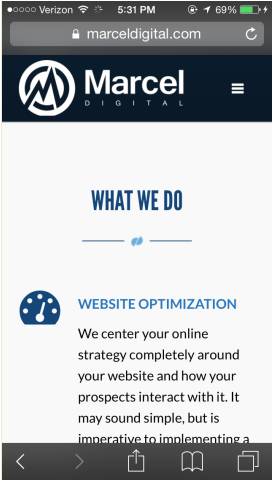
There are many stages involved in launching a new website or revising an existing site. Once the website is fully developed, testing is often ignored and overlooked. Thoroughly reviewing a website and testing its functionality before the site is launched can catch errors that would deter visitors from completing the goal of the site and would create an undesirable user experience.
When testing a website, you should always compile your findings into one document. Be specific with what you see. Include page URLs for reference and screenshots where possible. This will help your developers organize feedback and provide additional notes.
What Should You Test?
1. Homepage
The homepage is often the first page a user will see to introduce them to the website. Ensure the homepage layout and content conveys the goal of the website and is also easy to navigate. Make sure that the way the developers deployed the designer’s vision is consistent with the design you approved.
2. Navigation
The purpose of the navigation is to allow visitors to access key pages from all areas of the website. It is important to check each link within the navigation to make sure the links are pointing to the correct page. This is essential for both usability as well as search engine optimization. Additionally, if search engines have difficulty crawling your navigation it has the potential to produce negative results.
3. Content
Review all content sitewide. Content is often copied and pasted from Word documents. Any misspelling, bad use of grammar, or typos can be accidentally pasted into the new website. Evaluate these errors and formatting of all content including headers, links, URLs, and title tags. Do not be overly concerned if there is additional content you want to add to the website as there will always be changes needed for a website. Try to think about what is most critical for site launch, and what can be added post-launch.
4. Form Submissions
Evaluate all forms on the website. When testing forms on the new website, you should check the following:
- Am I able to complete the entire form with no errors?
- If you enter a form field incorrectly is the error messaging simple and clear to the user?
- Are there fields on the form that can be eliminated to shorten the process for the visitor?
- Is the form submitted to the correct inbox or CRM?
- Are you receiving all required information from the visitor such as name, email, etc?
- Is the visitor receiving the correct message once the form is submitted?
5. Placing Orders - Checkout and Payment (eComm sites only)
Complete the checkout and payment process for an eCommerce site (preferably on a development site.) When reviewing the checkout process, ensure the final payment amount is correct. Change different attributes, such as quantity or delivery method, to confirm the final payment amount.
Test each payment method that is available on the website. This should include all methods of payments allowed for your website. If confirmation emails are sent once payment is complete, confirm that all emails are routed to the correct inboxes.
6. URL Mapping (Map of old pages to new pages)
When redesigning a website, it is critical that old pages are redirected to their new counterparts. The process of URL mapping is to map the old pages to the new pages. It helps ensure users are provided a seamless transition from the old site to the new site and is also beneficial for search engines to transfer equity from the old pages to the new pages.
Review the URL map to guarantee the redirects will be correct when the site launches.
7. Social Media Icons
Verify that any social media icons on the website are going to the correct social pages. If areas of the website have social sharing functions (for example your blog or any newsletters), test to make sure they are behaving and posting correctly.

8. Mobile/Tablet/Responsive
With the continually rapid increase of smart phones, new sites are typically designed to be responsive or to have a mobile-specific layout. The new site should be reviewed on mobile devices and tablets to ensure a positive user experience and to confirm that the site is rendering as intended. This should initially be tested during the template stage when reviewing the static templates of the website. However, it should be tested again when content is loaded, to ensure formatting is correct.

9. Analytics and Other Tools
Confirm website tools used for optimization are installed and ready to deploy. Some tools such as Google Analytics will need to be on the site before it launches. This helps benchmark and track how the new site performs during and post launch. Others tools, such as Google Webmaster Tools, will need to be deployed after launch when the website is live. These and more tools can be added through Google Tag Manager, which can also be added to the site before it launches.
This checklist provides a starting point for users who are testing the front-end of a website. Your developers should also have a more comprehensive checklist that includes cross-browser testing, crawls to check for broken links, and other functionalities that ensure your site is operating properly from a technical standpoint.
Web Development
About the author
Alex Vilmur
Alex Vilmur is a wizard at development and also trumpet. He once auditioned for The Mighty Mighty Bosstones, but found his passion for website development and Umbraco made it too hard to leave.